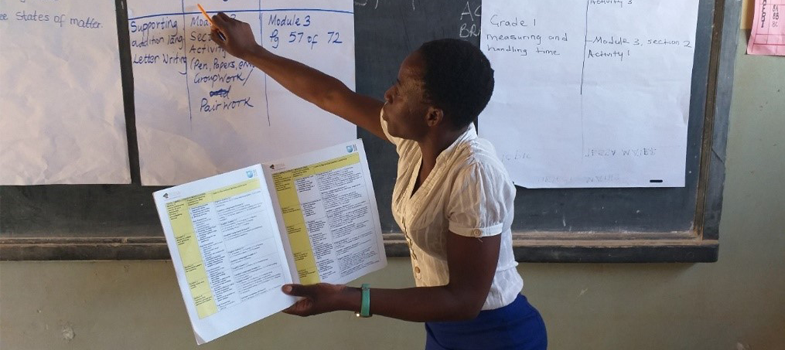Training guide
2. Developing participatory TGMs
2.1. Planning TGMs
Careful planning is key for successful meetings, as it is when planning a lesson. You need to think about the objectives that you want to achieve in the meeting and the kinds of activities you will use to meet your objectives. The training resources have activities for you to do together in your meetings. Facilitators need to plan the details of the meetings, and teachers need to prepare themselves by reading the training resources in advance. The activities suggested are relevant to your classroom practice and offer opportunities to discuss and try out ideas that can then be used in your lessons. It is not enough to simply know the theory about learner-centred teaching and learning; what is most important is to develop confidence in trying out these approaches in your own classrooms.
Example 4.1: Thinking about TGMsSIC James ran the first TGM of the term. He planned the meeting very carefully – reading the materials he would use and trying the activities for himself before the meeting. He found some of the teachers reluctant to share their ideas but realised this was probably because they were usually just asked to sit and listen. For the second meeting, he asked for volunteers to facilitate and Joyce volunteered. James was a little concerned because he knew that Joyce was extremely busy. She was also very confident and enjoyed leading TGMs as it provided an opportunity for her to explain her approach to teaching. However, James did not want her to give a lecture! So a few days before the meeting, he made sure that he had a cup of tea with Joyce and asked how she was getting on with planning the meeting. She seemed surprised that he had asked and reminded him that she was very experienced at running TGMs. James explained he just wanted to make her aware of the resources she had access to, to assist her in planning the TGM. He logged on to the Raspberry Pi, in the staffroom and showed her the outline for the TGM about role-play and story-telling. He also drew her attention to the facilitator guide and asked her to make a plan and share it with him the next day. He also explained that the aim was to make the TGMs more participatory than they used to be and to actively involve all the teachers. If they were expected to do this in their own classrooms then they needed to experience some of the approaches for themselves! The next day James noticed Joyce talking to a group of teachers, reminding them to look at the Training Materials in advance of the meeting. On the day of the meeting, she introduced the topic, but allowed the teachers plenty of time to talk in groups. By the end of the meeting, they had done two activities and everyone had a plan for an activity in their classroom. She allocated teachers to groups and when James asked her afterwards how she chose the groups, she said she had purposely mixed up the subjects because literacy and social studies teachers were generally more confident in role play and she wanted them to help the numeracy and science teachers. James was impressed. He also noticed that teachers were more willing to participate than in the previous meeting. Afterwards several teachers said how much they had enjoyed the meeting. That week, James also noticed lots of enthusiasm amongst learners as they talked about some of the activities they had done after the lesson. |
Activity 4.4: Reflecting on Example 4.1After you have read the example above, make a few notes in your Teacher Notebook in response to the questions below to discuss at the TGM
|
